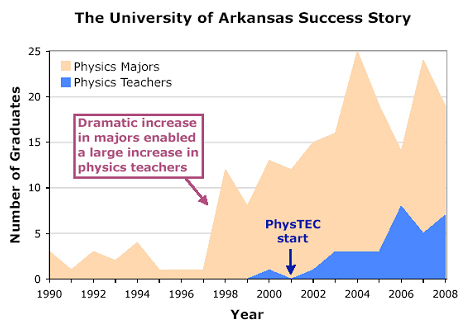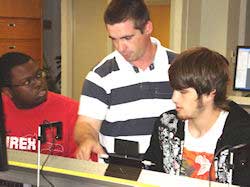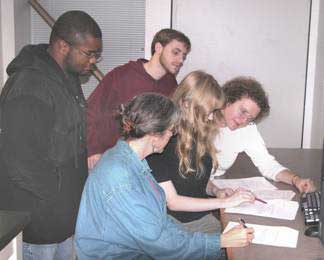College Ready in Mathematics and Science Partnership:<br> University and School District Partners working together to improve student success and teacher preparation
Teacher Preparation Section
Gay Stewart
The College Ready in Mathematics and Science Partnership is a five-year, $7M, targeted Math Science Partnership funded by the National Science Foundation to enhance mathematics and physics learning for all students in its partner districts and teacher-preparation programs in partner institutions, closing achievement gaps, and preparing students for success in mathematics, science, and teaching careers. College Ready will build vertical and horizontal learning communities among school and college faculty in order to improve major issues that impact the successful transition of students from high school to college, targeting physics. College Ready focuses its work on the school-college critical juncture and therefore is centered on articulation issues between school and college–teacher preparation in college for work in schools and student preparation in school for college mathematics and science, as well as among colleges and disciplines.
Successfully building partnerships is central to any effort to enhance K–12 teacher education. K–12 faculty work within a much different structure with many more constraints than college faculty. We started out working with teachers who had come to us with various questions or suggestions. We got to know them and earned their respect, and the respect was mutual. These teachers reciprocate by serving as our experts on teacher needs and teaching. Building these relationships with individual teachers eased forming collaborations with district-level personnel. Working with some schools gave us better entrées into other districts. Opening these collaboration discussions with money ideas helped. Our first partnership request to a district was to work together on a state Teacher Quality Enhancement proposal, the year before the Physics Teacher Education Coalition (PhysTEC) was officially formed. Actually producing teachers, and placing them into area schools, further strengthened our partnerships, opening more dialogue with building-level administrators.
College Ready's core partners include 38 school districts in Arkansas and Oklahoma, the University of Arkansas, Fort Smith, and the University of Arkansas, Fayetteville (UAF), which serves as the lead. The supporting partners are APS, AAPT, College Board, Mathematical Association of America, Maplesoft, and Northwest Arkansas Community College. College Ready will carry out a series of interconnected activities including vertical alignment of high school and college expectations, intensive content-driven workshops, university course and program revisions, the creation of professional learning communities, and the opportunity for teachers to earn advanced degrees and endorsements. The physics workshops utilize materials and master teachers from the Physics Resource Teaching Agent (PTRA) program. College Ready builds on and looks to establish synergy between established efforts of PhysTEC and Preparing Mathematicians to Educate Teachers (PMET).
There is a strong desire nationally to increase the number of students preparing to teach in STEM fields. The UAF physics department has been significantly engaged in the preparation of pre-service teachers for eight years, building on major efforts to reform their undergraduate program, which received NSF support in 1995. UAF has seen a dramatic increase in both the number of physics majors and of physics teachers produced, as shown in the figure, distributed by the American Physical Society as an exemplar of both the new "Doubling Initiative" and PhysTEC. UA's PhysTEC philosophy is that there are reasons you want teachers to teach in certain ways, and so you should model this pedagogy for all students, improving their learning and providing future teachers with good models of instruction. Many of the changes that have made these dramatic increases possible would be transportable to the mathematical sciences. Like physics, mathematics has the goal of improving its service to all students, with a significant impact on those who will later teach. Not only will this program have a significant effect on the number of future teachers, but on student success at the university, particularly in STEM fields. Mathematics and physics are typically "gatekeeper courses" for other STEM majors. Reforming introductory physics courses into experiences that not only provide significant student learning, but also develop skills necessary for success in subsequent STEM courses, has increased graduation rates in engineering markedly. Physics is the most successful course in the new freshman engineering program, built at UAF to enhance the retention of engineering majors.

Mathematics is already working with PhysTEC faculty on how to bring some of the successful course policies to the calculus sequence, which remains a barrier for many students. Additionally, improvement of the calculus sequence, increasing student engagement in the material, will positively impact physics majors, especially teachers, most of whom go on to certify in both physics and mathematics. Having a major impact on other departments was not a primary goal of PhysTEC. But establishing a successful preservice teacher program in another STEM department would be a positive model to institutions nationwide.

Undergraduate Learning Assistant Shane Carey, a Noyce scholarship recipient and future high school physics teacher, works with two University Physics I (UPI) students at UAF, Stephen Brinson, left, and Mark Blanco. UPI is one of the courses strongly reformed under the PhysTEC project. It serves as a core course in the Freshman Engineering program, as well as providing an excellent early teaching experience.
Over 600 grade 7–12 teachers of mathematics and science currently teach at the partner schools, and the school districts are in the process of expanding, with a new high school just opened. Most of these teachers have at least an endorsement for their area of teaching, although few have degrees in their field. (For instance, eight that are currently teaching physics in partner schools have degrees in physics or physics teaching.) Because of the integration of the sciences in the Arkansas standards (over 500 of these teachers are in Arkansas school districts), teachers prepared to teach earth or life science are also finding themselves required to address physics strands. Licensure can be obtained in the area required for teaching high school physics with as little as two introductory algebra-based physics courses and a physical science content exam. Statewide, approximately 80% of physics teachers have a biology background. This is improving slowly. Similarly, licensure can be obtained in the area required for teaching high school mathematics with as little as Survey of Calculus as the most advanced mathematics course taken.
The master teachers will participate in three years of continuous, content-based professional development, which will reach approximately 50% of the mathematics and science teachers in the partner districts. There are also quantitative literacy and vertical teaming workshops, where master teacher candidates will be working with other teachers from their school districts to achieve the horizontal and vertical teaming goals. There are also some content-specific workshops. For instance high school physics teachers preparing to teach an AP calculus course will be able to attend just the AP calculus portion of a mathematics workshop series. The project expects to have worked with at least 500 mathematics and science teachers directly, and to have impacted all of them, over the course of the project.
This project dovetails directly into the long-range plans of all partners. All partners seek to increase the overall achievement of their students. Increasing students' abilities in literacy and math skills is essential to overall performance, not only because these content areas are measured regularly on standardized tests, but also because these areas are fundamental to further learning in all content areas.

Gay Stewart (right) works with undergraduate learning assistants on developing grading rubrics to encourage students to demonstrate conceptual understanding. (Left to right) Marshall Scott, Noyce Scholar and future high school physics teacher, and Christopher Jackson, high school physics teacher, are just joining in the discussion. Belinda Hendley, new Noyce graduate, still looking for a physics teaching position, and Elaine Christman, high school physics teacher and Amgen Fellow in Teach for America, are already at work. In the fall of 2007, when this photo was taken, the students were all still undergraduates, and Marshall had not yet expressed an interest in high school teaching.
The school districts become partners because they are deeply committed to the success of their students in mathematics and physics and in the preparation of those students to enter college with a realistic expectation that they can and will succeed in STEM fields. They believe that the key components to achieving these two goals are (1) providing rigorous, successful high school courses and curricula, (2) building the capacity of teachers to offer such courses, and (3) working with universities to a) identify areas where students need extra support, and b) provide placement mechanisms so that students are likely to succeed in colleges that are better informed of students' progress on the educational continuum. These efforts are most seriously impeded by the inability of school districts to provide high-quality, discipline-specific professional development to teachers of mathematics and physics. This is directly addressed by the partnership by providing significant training over the funding period to a large cadre of teachers within these school districts to become resources to the districts. These master teachers will then form the nuclei of professional learning communities in their schools that will allow them to direct peer-led professional development into areas of greatest need. This will allow the achievement of these goals to be sustained beyond the end of the funding. The school districts are committed to providing the necessary infrastructure support for this in-service professional development, reaching teachers that do not participate directly during the project, as well as beyond the funding period. The schools will nurture these professional learning communities that are, frankly, needed to support the learning of all students in mathematics and science. It is envisioned that if these teachers change schools in the future, they will be seen as valuable resources to their new schools as well.
Gay Stewart is an Associate Professor of Physics at the University of Arkansas – Fayetteville. She received her PhD in experimental high energy physics from the University of Illinois Urbana-Champaign in 1994. Since then she has been actively engaged in physics education reform, and, since 2000, in physics teacher preparation.
Disclaimer - The articles and opinion pieces found in this issue of the APS Forum on Education Newsletter are not peer refereed and represent solely the views of the authors and not necessarily the views of APS.
